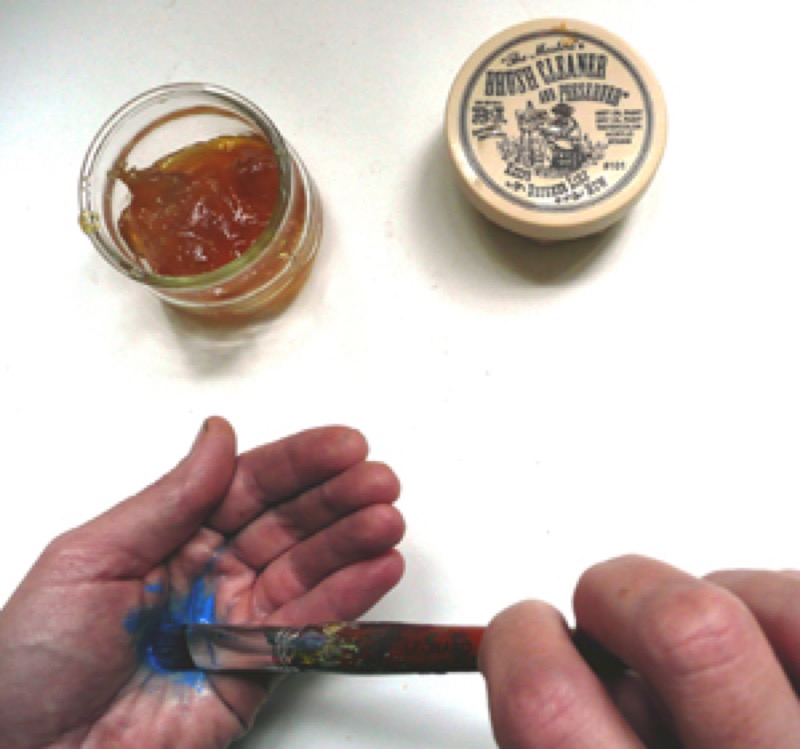Oil painting supplies and materials require tender loving care! They need to be thoroughly and carefully cleaned after each use.
1. Colors
Oil colors keep well… provided you follow a few very simple rules!
- While working: squeeze from the end of the tube rather than right below the neck.
- After painting: wipe threads with a rag before screwing the cap on the tube, to keep it from sticking. If it is stuck: place the tube in hot water or over a source of heat (a radiator) until you can unscrew it without forcing.
Roll up the empty part of the tube. This will allow you to gauge at a glance how much paint you have left!
Remember
Store your paints in order in a wood or metal paint box. By shade, from warm to cool colors… there is no set rule, so long as you don't have to rummage around for hours every time you use them!

2. Paintbrushes
They need to be carefully cleaned after each painting session: This is the golden rule for retaining a good brush stroke over time!
5 steps to a clean paintbrush:
- First, remove all excess paint from the bristles with a piece of paper (a page from a newspaper, for example) or a rag, working from the ferrule down to the tip of the bristles.
- Rinse the bristles in white spirit then dry them with a rag.
- Because white spirit is corrosive, wash paintbrush bristles again in the hollow of your hand with some soap and warm water until the soapy water no longer shows any paint color.
- Gently smooth the bristles between your thumb and index finger to get all the bristles back in place.
- Let your paintbrush dry lying flat, on absorbent paper or a hand towel. Once dry, store in a paintbrush container with the bristle end up.
Remember
While turpentine is the best solvent, it is also very expensive and particularly irritating to the skin and mucous membranes. You can replace it with white spirit. There are also towelettes moistened with solvent to use for cleaning your material without harming your hands.
3. Knives and spatulas
Don't allow paint residue to dry: you might no longer be able to remove it and could lose the smooth surface you need for working with a palette knife or spatula.
Rub with a cotton rag moistened with white spirit.
4. Palette
Right after a painting session, remove excess paints with a spatula or palette knife. you can save them, each in a closed container, for reuse the next session: to prepare your colored background, for example.
- Remove leftover paint with a rag moistened with white spirit.
- Once the palette is clean, apply a little linseed oil to treat the wood: it will retain its shiny appearance and smooth surface.
Trick of the trade: throw out your palettes!
If you can't stand cleaning up, consider disposable palettes! They are made of paper specially treated for mixing colors, with a very stiff cardboard back, to make it comfortable!
5. Thinners
There's no point in throwing out the turpentine or white spirit you used for painting: recycle them!
- Pour the cups of thinner into a jar.
- Filter the contents (with a coffee filter, for example). Repeat until there is minimal paint sediment: your thinner is all ready to use again!
- Is your thinner saturated with paint? don't throw it down the sink! Store it in a jerry can and carry it to a garage that has a tank for this kind of product. A simple way to save the environment!
6. Storing your material
Oil painting involves owning a large number of often costly materials. This is why you need to keep them in good shape for as long as you can. Keep your material together in one place to make it more accessible when you want to start painting!
- Paints, thinners, media and varnishes: store at room temperature (15° to 25° C). Avoid storing in a garage, garden shed, or any place overly exposed to cold, because paint thickens and other products become dull at low temperatures.
- Dry your work in a sheltered, dust free place that is neither too cold nor too damp (15° to 25° C).
Recommended product:
Figueras®
